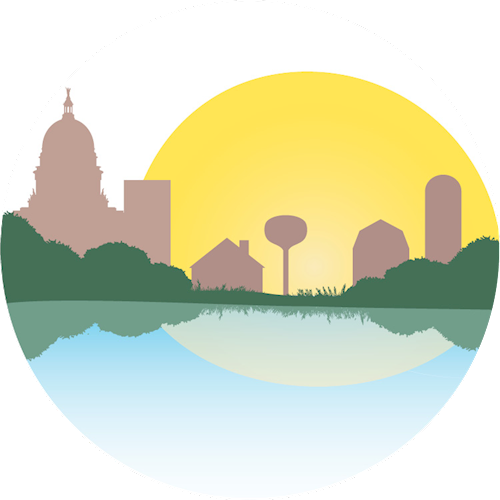
Heather Phelps
 A historic building in central Madison just got a new lease on life thanks to the efforts of the Madison Meeting of the Religious Society of Friends. Originally built in 1914, the Meetinghouse has always been a place of worship. Through the years the building has hosted five different faith communities, finally ending up in the hands of the Madison Friends, also known as Quakers, in 1982.
A historic building in central Madison just got a new lease on life thanks to the efforts of the Madison Meeting of the Religious Society of Friends. Originally built in 1914, the Meetinghouse has always been a place of worship. Through the years the building has hosted five different faith communities, finally ending up in the hands of the Madison Friends, also known as Quakers, in 1982.
With their energy-related improvements and efficiency upgrades, the Dane County Office of Energy and Climate Change is proud to recognize their efforts this year as 4-star Climate Champions in the Building Design Category.
The community had considered making improvements to the building for more than a decade before the planning process got underway in 2016. Construction began in July 2021 and the renovation was completed 12 months later. The initial focus was on accessibility: the main entrance was too narrow to be easily navigated by wheelchairs, several of the restrooms required steps to access, and with no elevator the basement level could only be reached by stairs or an exterior path.
The project scope began to expand as the congregation considered its values and especially its concern for protecting the environment. After one member of the community offered a donation to install geothermal wells for heat pumps, support for achieving sustainability grew quickly during threshing sessions – meetings where members of the community discuss issues until they come to consensus.
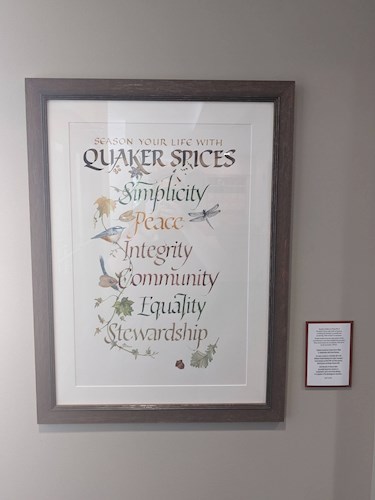
One of the traditional Quaker testimonies is Stewardship, which encompasses conserving the natural world, working to reduce one’s carbon footprint, and using the earth’s resources sustainably.
In the end, Friends approved plans to make the Meetinghouse accessible, sustainable, welcoming, and supportive of spiritual growth.
The first sustainability feature visitors notice as they arrive are the solar panels covering the entire south-facing roof areas. The 60 new solar panels produce ten times as much power as the ones they replaced, resulting in a 20 kilowatt-hour capacity.
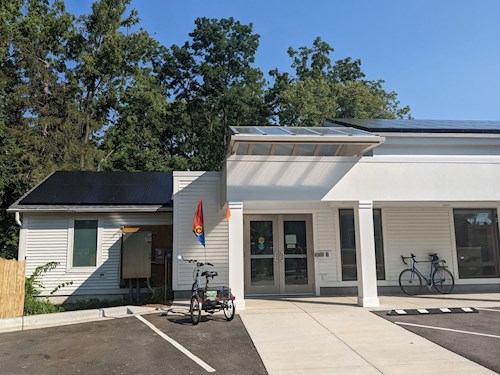
The remodeled entrance to the Meetinghouse, with solar panels visible on both sections of the roof.
The solar array also comes with an online monitoring system to allow the Friends to monitor exactly how much energy the building is using at any time. Eventually, they are hoping to make this available as a real-time display for the entire community to view. An sample plot of power production and consumption is shown below. The array is expected to produce 25,000 kilowatt-hours per year and provide 85-90% of the building’s annual energy usage.
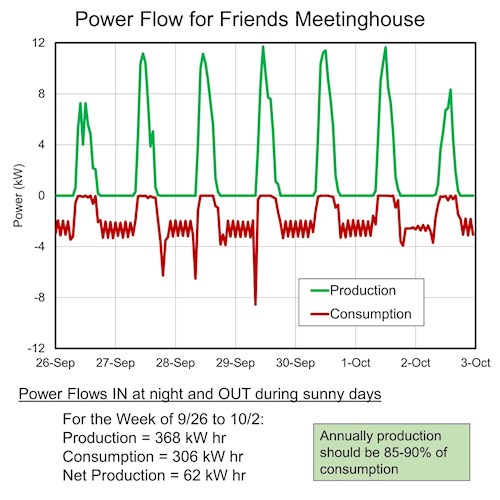
Solar production and energy usage of the building September 26-October 3, 2022.
Because Friends Meeting is non-profit, and thus not eligible for tax credits on solar installations prior to the passage of the Inflation Reduction Act, the community used a private LLC to help pay for the solar installation, following the model of Legacy Solar Co-op.
Another major sustainability upgrade was installing a geothermal system. This required drilling ten 250-foot wells underneath the parking lot. Propylene-glycol liquid circulates through pipes in the wells to heat pumps located in four zones of the building. With a soil temperature around 57°F year round, heat can be absorbed from the ground by these fluids in the winter to help heat the building. In the summer heat from the building can be transferred from the fluids back into the ground, air conditioning the building.
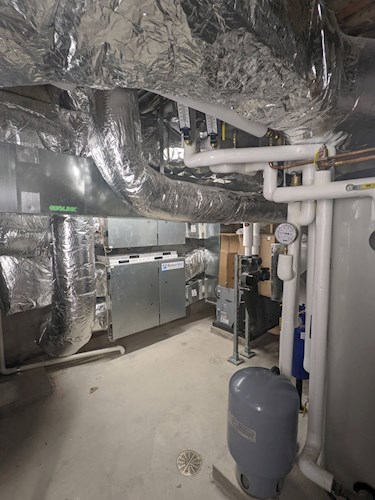
Internal components of the heat pump system, in the former furnace room.
To make the system as efficient as possible, Focus on Energy recommended adding insulation to the building, improving some of the windows, and installing LED lighting. Additionally, to meet the fresh air demands of the building codes, Energy Recovery Ventilators use air leaving the building to precondition air entering the building. These improvements not only made the building significantly more comfortable than previously, but in combination with the geothermal and solar systems the two gas-fired furnaces were replaced with four heat pumps, making the building totally electric. The building's gas hookup has been completely disconnected.
Other sustainability improvements include vestibules at each entrance to keep conditioned air inside, reused building materials, and natural landscaping. For example, doors from the old Meetinghouse were repurposed into new shelves and the landscaping includes native plants, a butterfly garden, and a rain garden.
In addition to making the building more accessible, it is now significantly larger, going from 6267 sq. ft. to 8006 sq. ft. The additional space allows for more fellowship areas, new classrooms for children and teens, and improved traffic patterns. Multiple all-gender restrooms are available on each floor, all of which are now wheelchair accessible.
Friends are pleased that the renovation allows them to remain centrally located. On First Day – Quakers have traditionally preferred to avoid using the names of days of the week and months, given the pagan origins of many of those names – the side lawn of the building is full of bikes people have ridden to Meeting. With Friends coming from close enough that they can bike, walk, or ride the bus, the Meetinghouse only requires a small parking lot for a church their size.
In their application for a Climate Champion award, Madison Friends Meeting summarized their project by saying, “Our goals of environmental stewardship were advanced by converting completely to renewable energy systems. The building renovation creates a space that is accessible, spiritually uplifting, and welcoming to all. Friends believe the energy-efficient Meetinghouse can serve as a model for other congregations, and it provides a low-carbon facility where community groups can hold activities.”
The Dane County Office of Energy and Climate Change is proud to recognize Madison Friends Meeting as a 2022 Building Design Climate Champion.